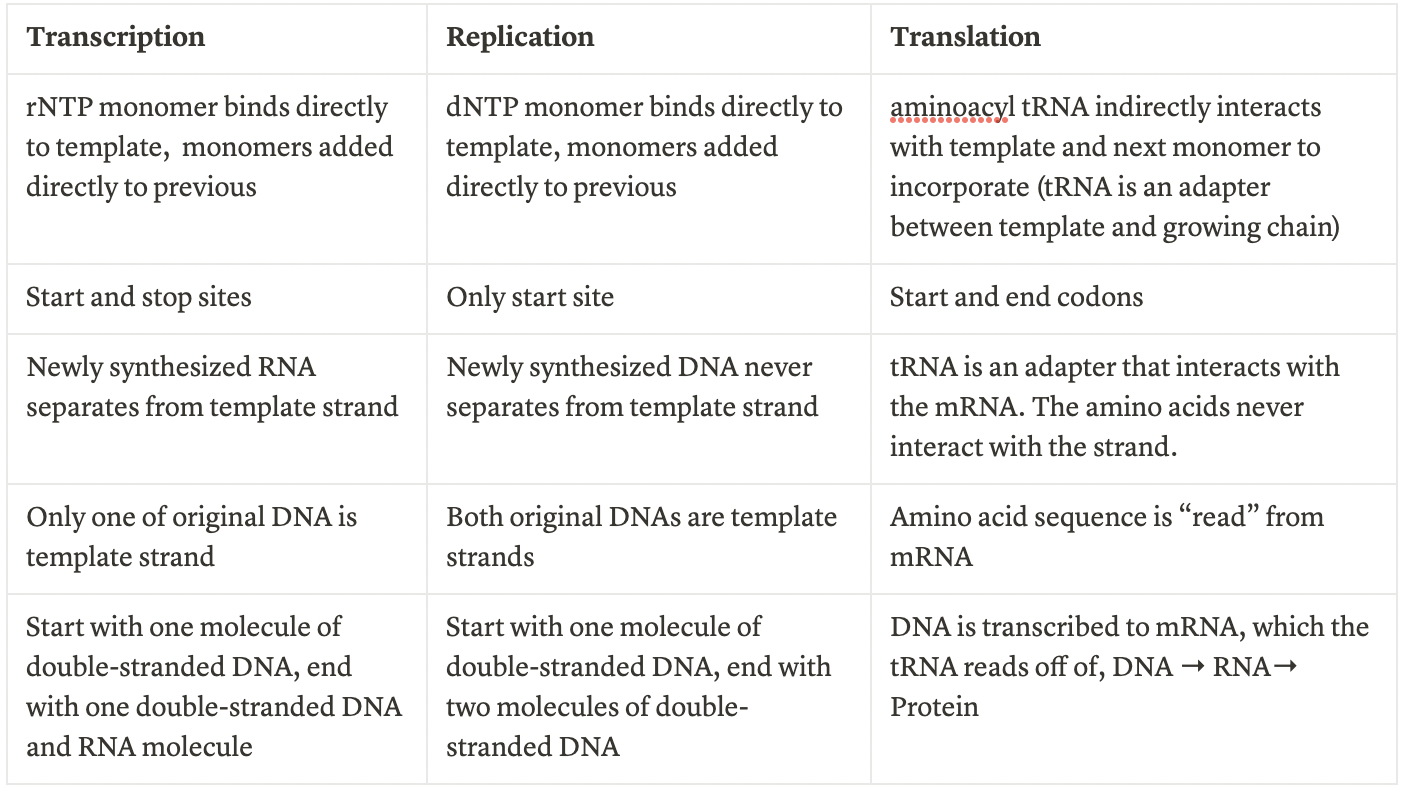Linear Biopolymers and Central Dogma
0.0(0)
Card Sorting
1/19
Earn XP
Description and Tags
Study Analytics
Name | Mastery | Learn | Test | Matching | Spaced |
|---|
No study sessions yet.
20 Terms
1
New cards
Polymer
Covalent bond-linked chain of monomers
- Informational polymers have more than one kind of monomer, and the order of monomers is the information (DNA, RNA)
- Informational polymers have more than one kind of monomer, and the order of monomers is the information (DNA, RNA)
2
New cards
Joining Sites
The places where polymers can connect together, due to the chemistry of the monomers within.
- One joining site = no joining sites exposed at ends, no further side chain growth (only two monomers)
- Two joining sites = linear polymers of potentially infinite length
- Three joining sites = branched polymers (informational biopolymers are NOT branched)
- One joining site = no joining sites exposed at ends, no further side chain growth (only two monomers)
- Two joining sites = linear polymers of potentially infinite length
- Three joining sites = branched polymers (informational biopolymers are NOT branched)
3
New cards
Asymmetry of Informational Biopolymers
Made from asymmetric monomers, two joining sites but they are different
- asymmetry of monomers drives asymmetry of polymers
- DNA, RNA, and protein, growth of the chain occurs only at one end (unidirectional)
- asymmetry of monomers drives asymmetry of polymers
- DNA, RNA, and protein, growth of the chain occurs only at one end (unidirectional)
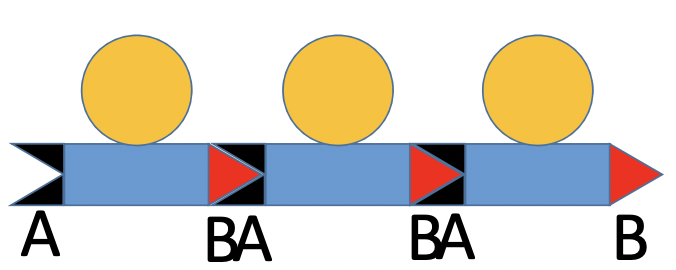
4
New cards
Nucleotides
Made of a polymer backbone (pentose sugar phosphate), with a characteristic heterocyclic base.
Join to each other on the 5' phosphate (negative) and 3' hydroxyl
Join to each other on the 5' phosphate (negative) and 3' hydroxyl
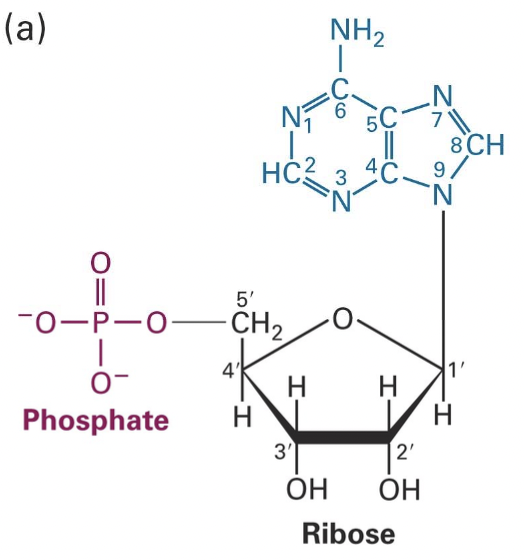
5
New cards
DNA vs RNA Hydroxyl
Differ in the pentose sugar, Deoxyribose is missing the 2; hydroxyl of ribose. This makes DNA much more resistant to chain cleavage by hydrolysis - greater stability.
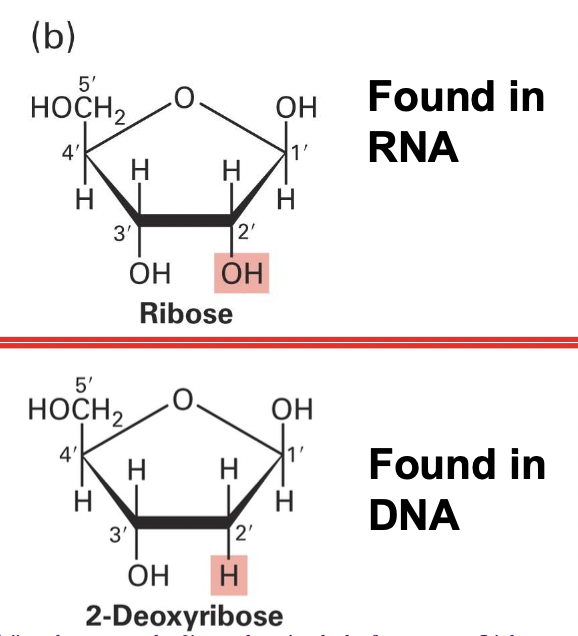
6
New cards
Heterocyclic Bases of Nucleotides
Purines: Adenine (A), Guanine (G)
Pyrimidines: uracil (U), Thyime (T), Cytosine (C)
Purines are larger, have the same basic ring structure but different add-ons. Pyrimidines have a single ring.
The methyl group on the 5' carbon of T makes it easier to repair mutations
Pyrimidines: uracil (U), Thyime (T), Cytosine (C)
Purines are larger, have the same basic ring structure but different add-ons. Pyrimidines have a single ring.
The methyl group on the 5' carbon of T makes it easier to repair mutations
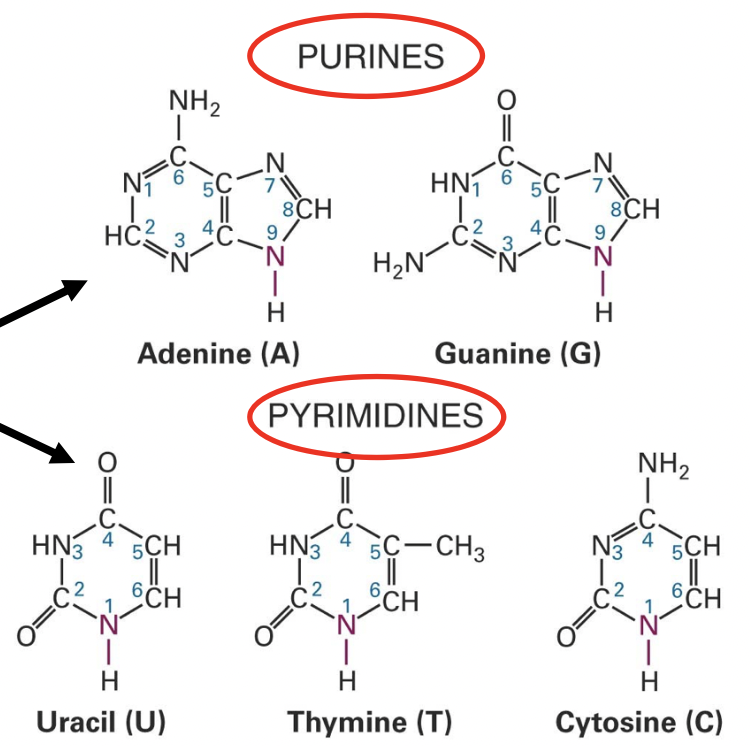
7
New cards
Protein Monomers and Their Growth
The monomers are amino acids. The characteristic element is the amino acid side chain (R). The two joining sites are the amino (NH2) group and the carboxyl (COOH) group.
- Polymer growth is at the carboxyl end
- Polymer growth is at the carboxyl end
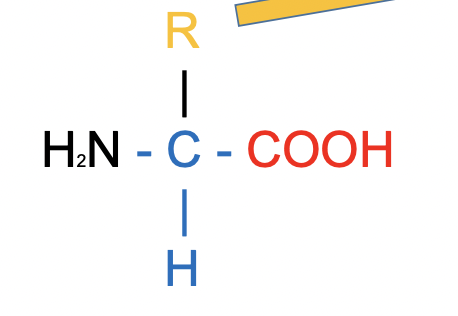
8
New cards
Side Chains of Amino Acids
There are 20 different amino acid side chains, their chemical properities define three main classes of amino acid
1. Hydrophobic (8 amino acids)
2. Hydrophilic (includes acidic and basic, 9 amino acids)
3. Special (3 amino acids)
1. Hydrophobic (8 amino acids)
2. Hydrophilic (includes acidic and basic, 9 amino acids)
3. Special (3 amino acids)
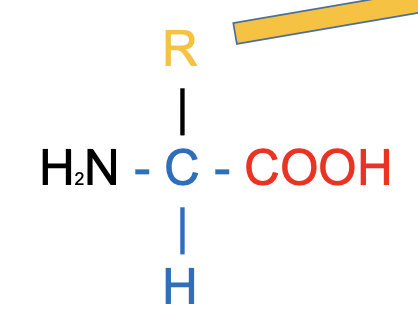
9
New cards
Adding Monomers to a growing Polymer Chain
The monomers need to be put in a higher energy state to be added to a chain
- nucleotide monomers are in the form of high-energy nucleotide triphosphates (NTPs)
- hydrolysis across the bond and the molecule is transferred to the chain, which is thermodynamically favourable. The outer two phosphates are "kicked out" when the NTP is incorporated into a growing nucleic acid chain
Even already energized monomers need an enzyme to catalyze the linkage reaction (ex. DNA polymerase)
- nucleotide monomers are in the form of high-energy nucleotide triphosphates (NTPs)
- hydrolysis across the bond and the molecule is transferred to the chain, which is thermodynamically favourable. The outer two phosphates are "kicked out" when the NTP is incorporated into a growing nucleic acid chain
Even already energized monomers need an enzyme to catalyze the linkage reaction (ex. DNA polymerase)

10
New cards
tRNA
Amino acid monormers are in the form of high-energy amino-acyl-tRNA esters.
- the tRNA molecule is kicked out when the next amino acid is incorporated at the end of a growing polymer chain
- the tRNA molecule is kicked out when the next amino acid is incorporated at the end of a growing polymer chain
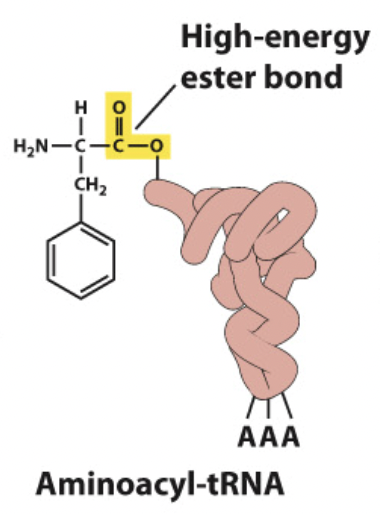
11
New cards
DNA Structure
DNA strands are double-stranded (duplex DNA)
- held together by hydrogen bonds between complementary bases = watson-crick base pairs
- two strands are antiparallel
- they can be either left or right DNA (think about going up a spiral staircase, hand can be on the left or right)
- breaking these H-bonds allows the strands to separate, called denaturation
- held together by hydrogen bonds between complementary bases = watson-crick base pairs
- two strands are antiparallel
- they can be either left or right DNA (think about going up a spiral staircase, hand can be on the left or right)
- breaking these H-bonds allows the strands to separate, called denaturation
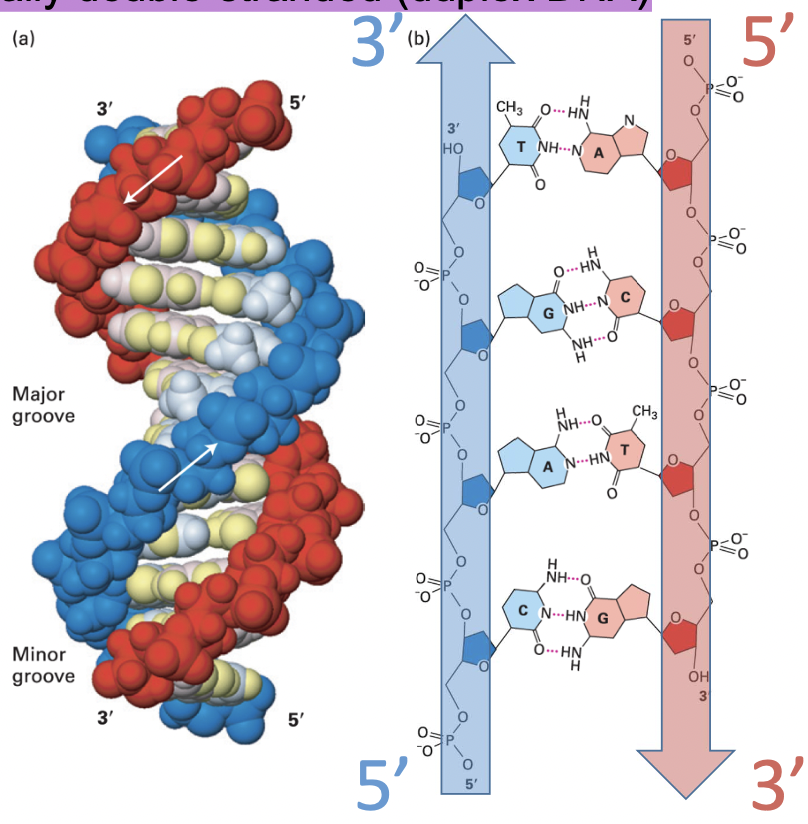
12
New cards
Uses of Major and Minor Grooves
DNA-binding proteins can make contact with BPs at major and minor grooves without having to separate the strands.
13
New cards
Denaturation and Tm
Tm is the temperature at which the DNA is one-half melted, which depends on its base composition
- DNA with a higher proportion of G-C BPs have a higher Tm, because they have more hydrogen bonds (3 H-bonds vs A-T having 2 H-bonds)
- DNA with a higher proportion of G-C BPs have a higher Tm, because they have more hydrogen bonds (3 H-bonds vs A-T having 2 H-bonds)

14
New cards
Central Dogma
DNA synthesizes DNA (heredity) -> RNA -> proteins
DNA synthesis is replication (making a perfect copy)
RNA synthesis is transcription (rewriting in a different nucleotide font, from dNTPs to rNTPs)
Protein Synthesis is Translation (rewriting in amino acids instead of nucleotides)
DNA synthesis is replication (making a perfect copy)
RNA synthesis is transcription (rewriting in a different nucleotide font, from dNTPs to rNTPs)
Protein Synthesis is Translation (rewriting in amino acids instead of nucleotides)

15
New cards
Transcription
Makes an RNA that is the same sequence as the non-template strand (both are complimentary to, and antiparallel with, the DNA template)
- DNA strand is exposed, this is the template strand
- RNA directly interacts with the template using the incoming monomer (rNTP) and only links if it forms a perfect pair
- RNA chain runs antiparallel to DNA, adding in the 3' direction
- DNA strand is exposed, this is the template strand
- RNA directly interacts with the template using the incoming monomer (rNTP) and only links if it forms a perfect pair
- RNA chain runs antiparallel to DNA, adding in the 3' direction
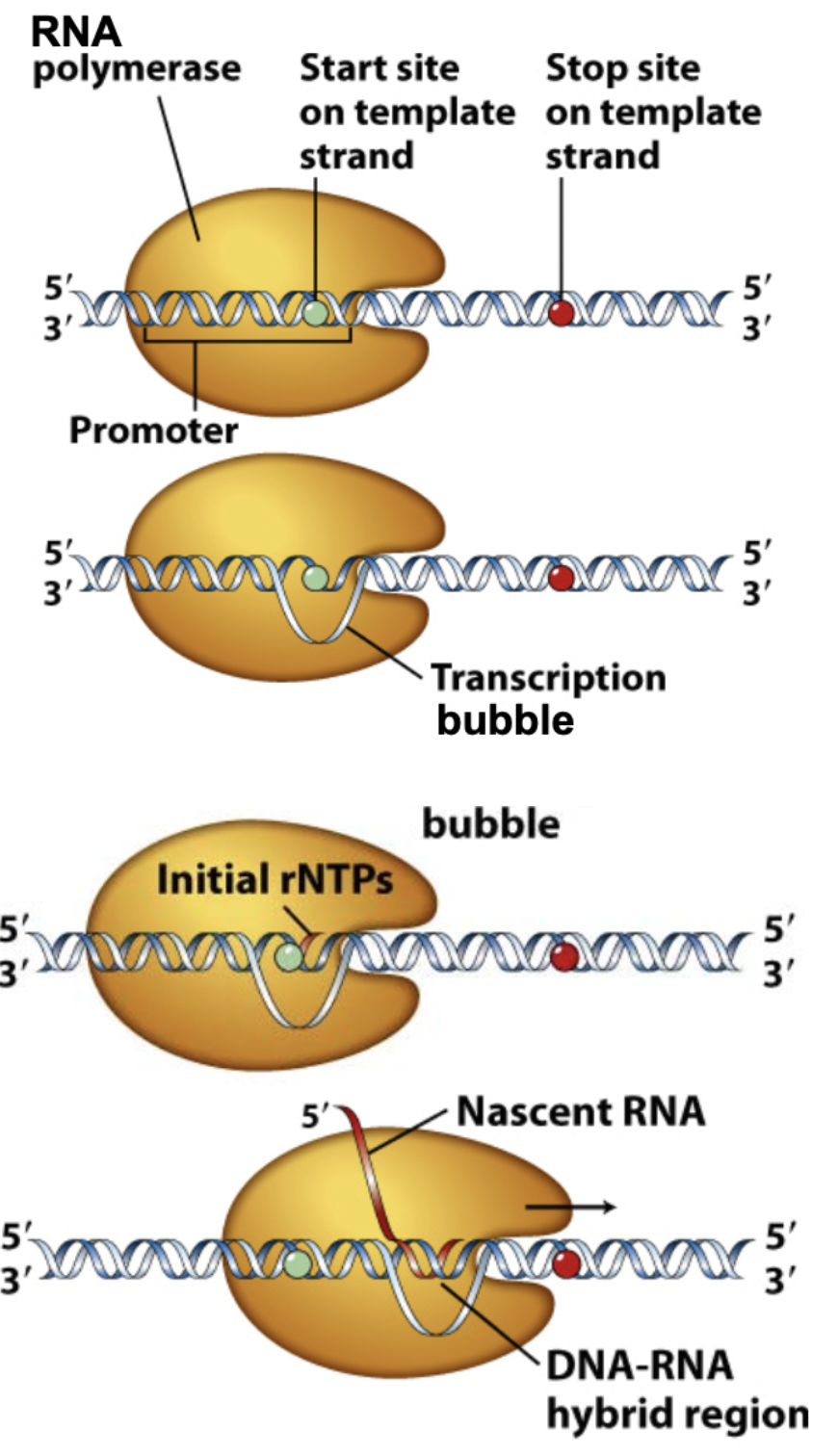
16
New cards
Transcription Bubble
Separates a small section of DNA at a time, where RNA polymerase binds to the promoter region and helicase locally separates the strands of DNA.
Moves along the DNA with RNA polymerase, transient unwinding.
When the original DNA duplex reforms, energy is released, allowing the newly-formed RNA to be taken off the template, and exit through a channel in the polymerase.
Moves along the DNA with RNA polymerase, transient unwinding.
When the original DNA duplex reforms, energy is released, allowing the newly-formed RNA to be taken off the template, and exit through a channel in the polymerase.
17
New cards
DNA Replication
Uses DNA as a template to make more DNA
DNA is unwound locally by helicase to expose the template and start sites, and the new strand is synthesized 5' to 3' antiparallel to the tempalte.
Monomers added are dNTP, interact directly with the template DNA with watson-crick base pairing.
Newly synthesized DNA does not unpair from the template strand.
- Start with one molecule of ds-DNA and end with two molecules of ds-DNA
DNA is unwound locally by helicase to expose the template and start sites, and the new strand is synthesized 5' to 3' antiparallel to the tempalte.
Monomers added are dNTP, interact directly with the template DNA with watson-crick base pairing.
Newly synthesized DNA does not unpair from the template strand.
- Start with one molecule of ds-DNA and end with two molecules of ds-DNA
18
New cards
Codons
The 3-character "words" that for amino acids, coded by nucleotides. Despite 64 possible combinations from the amino acids, there are 20 amino acids - many codons code for the same amino acids.
19
New cards
Protein Synthesis - Translation
Taking the nucleotide sequence and translating into an amino acid sequence.
Aminoacyl tRNAs adapt the nucleotide code into an amino acid.
The signal end binds to the mRNA (which it's complimentary to).
Ribosome makes the link between the amino acid and the terminal carbon (called a peptidyl transferase reaction), catalyzed by rRNA floating in ribosome
Aminoacyl tRNAs adapt the nucleotide code into an amino acid.
The signal end binds to the mRNA (which it's complimentary to).
Ribosome makes the link between the amino acid and the terminal carbon (called a peptidyl transferase reaction), catalyzed by rRNA floating in ribosome
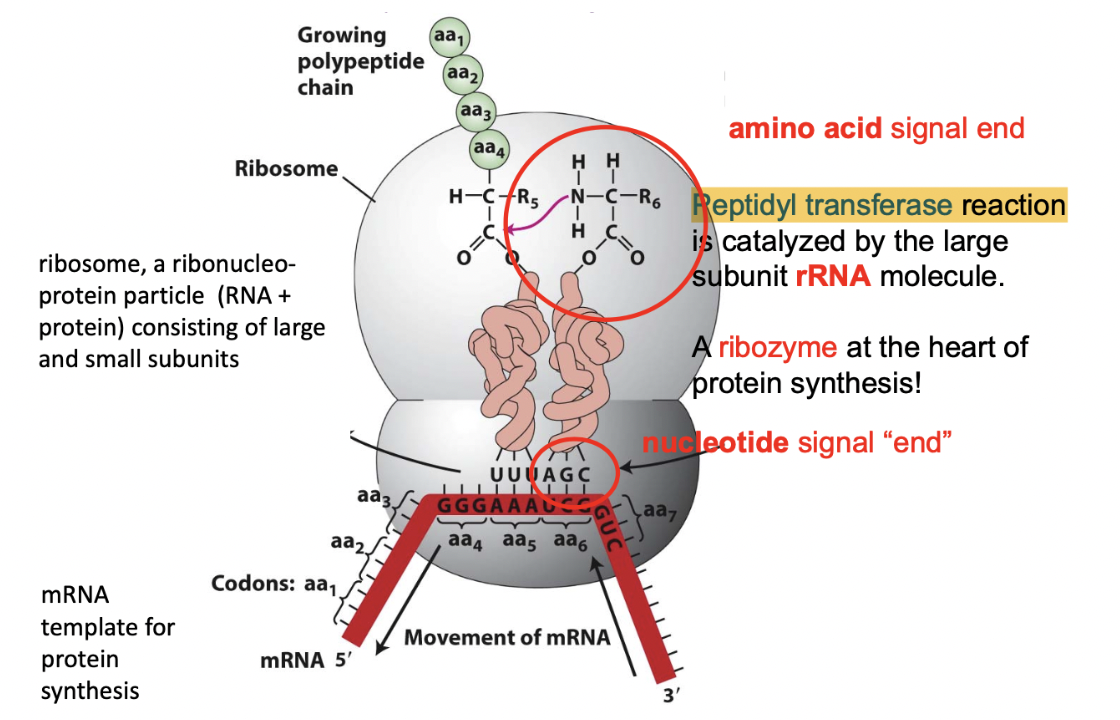
20
New cards
Summary Table of Transcription, Replication, and Translation
